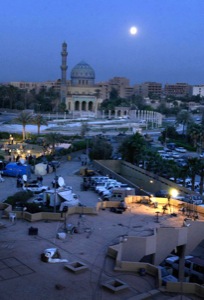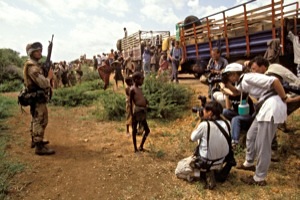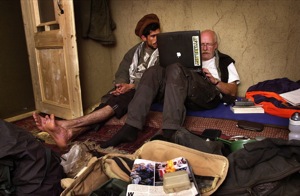The Political Economy of News Media Production & Consumption
By Caitlin Patrick
The political economy of media production and consumption is both an area of rapid historical changes yet also of strong continuities. Many might argue that little has changed since the early days of mass-market newspapers in the nineteenth century, which were often owned by political party members in Britain and used to propagate their ideas to the public and discredit opponents. The news has always been a brand and editorial experience that goes beyond merely obtaining information and facts. While early newspapers were fairly transparent about their motives and masters, however, modern media has not continued this trend in many cases. In the late twentieth and early twenty-first centuries much of global media have become multinational and conglomerated businesses with complex chains of ownership and holdings that usually include several different media types. Democratic societies have long recognized the importance of free speech and informed citizen debates and the ways in which news media support or hinder these ideals in the increasingly global political economy is a question of great importance.
The majority of Western media organizations, with the exception of public broadcasters partly or fully funded by the state, are private, profit-making businesses that need to provide their shareholders with returns through the selling of advertising space. Thus, private media companies must preserve a good relationship with their advertisers: other companies. Many scholars and researchers, notably Noam Chomsky and Edward Herman, have argued that these conditions of existence create structures and operating procedures which make it difficult for individual journalists to present news contrary to the interests of the businesses which support their industry. This pressure is not usually overtly oppressive, but involves issues such as difficulties in financing news sources perceived by advertisers to be 'radical' or 'anti-capitalist'.

Kael Alford/Panos
Television lights outside the Palestine Hotel and the moon offer the only light in Baghdad after the US attack that knocked out the electricity grid. The hotel was home to most of the foreign press corps in Baghdad.
In the age of print and then television journalism dominance, high start-up and running costs made it difficult for small media outlets with little funding to survive. Indeed, the development of news agencies, notably the 'big three' - Associated Press, Reuters and Agence France Presse - occurred largely to provide first wire services and later photos and packages of audiovisual footage to news companies in order to make more coverage possible across great distances at high speeds. These agencies survive based on their being able to thrive in large economies of scale that have been traditionally needed to represent the world to audiences, a goal of many large news organizations, and by adapting to new technologies for the distribution of news to consumers.
Alongside the 'big three', however, smaller, specialized news photography agencies continue to survive and contribution many memorable photographs to the image economy. Created after World War II as a co-operative with the goal of providing photojournalists with more editorial control over their own images, Magnum Photos remains a significant player in the field of photojournalism. Other small agencies, such as the recently-created VII, aim to be "efficient, technologically-enabled distribution hubs" (VII website) for photojournalism, again signalling a broad-based awareness in this community of the importance of constantly facilitating and improving the flow of images to customers. With today's online technology, a major newspaper's staff may receive more than 6000 agency photos per day and all these organizations compete to provide the images that these news outlets will use. (Purdey & Owen eds., 2008: 75)
Besides the older ex-wire services and small boutique agencies like VII and Magnum, two other giants have emerged in the last 15 years to play a major role in the photojournalistic industry. Corbis and Getty Images are still and moving image distributors who have bought up much of the smaller photo agency competition throughout the 1990s. Corbis was created by Microsoft founder, Bill Gates, while Getty Images was started by Mark Getty "to bring the fragmented stock photography business into the digital age." (Getty website) Both these companies have diverse interests in images that reach well beyond conventional news/editorial photojournalism to include stock photography for advertising, sports and fashion photography and more. They have also acquired the rights to many collections of old iconic photographs of the nineteenth and twentieth centuries, as witnessed by Corbis' purchase of the historic Bettmann archive. Photo agencies of the 1960s, 70s and 80s with strong track records in news and editorial photography along with celebrity portraiture, such as Sygma, Liaison and Saba, were purchased by either Corbis or Getty as part of this consolidation trend.

Paul Lowe/Panos
Media circus photographing an American Marine with a malnourished boy during 'Operation Restore Hope' in Mogadishu, Somalia.
In the field of photography it is hard to overstate the importance of the Internet in creating new options for displaying and circulating work, either through the efforts of large businesses or at a more micro level. On industry forms like The Digital Journalist website, there has been significant debate between photojournalists as to which approach serves the photographer best. For those who are uncomfortable with working in the increasingly commercialized mass news media, displaying their images in books, exhibitions and gallery spaces or collaborating with non-governmental organizations can provide alternative ways and means of working. These outlets have been developing at least since the 1970s. Both Magnum and VII have ventured into audiovisual media production online (Magnum in Motion and VII Multimedia), presenting stories using a combination of text, still images, voiceover and recorded video footage. This field is expanding quickly; Media Storm, a project originally started at the University of Missouri School of Journalism in 1994, was re-launched in 2005 as a company dedicated to producing multimedia online productions for clients ranging from Starbucks to the Council for Foreign Relations. The desire for skills in multimedia production is also clear in demand for training workshops, set up by various businesses and organizations. These courses have drawn journalists and photographers, often from newspapers, who want to develop their multimedia skills for use in the paper’s website features.
An important aspect of the online world and many of its technologies is that they are available to non-journalists, providing them with a platform for creating and distributing their own stories and news. The role of the professional photojournalist is often said to be at risk due to the ability of many citizens to witness, photograph and display their work with ease, sometimes beating professionals to fast-breaking stories, such as the 7/7 bombings in London, or events that are being missed by most news media. However, as Gary Knight of VII Photos argues, there is still demand worldwide for professional photographers who have recognized credibility, experience and track records. The traditional importance of a strong visual style and diverse, new stories to tell remain as relevant for photojournalism today as in its heyday during the mid-twentieth
century period of the glossy news magazine.

Martin Adler/Panos
A journalist from the Swedish newspaper
Aftonbladet
types up a report on the latest developments in the war, with the help of his Afghan interpreter.
Click here for ‘The Political Economy of News Media Production & Consumption’ Bibliography section.
Click here for ‘The Political Economy of News Media Production & Consumption’ Links section.


